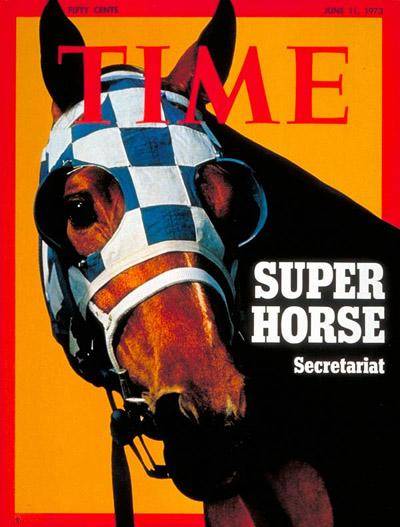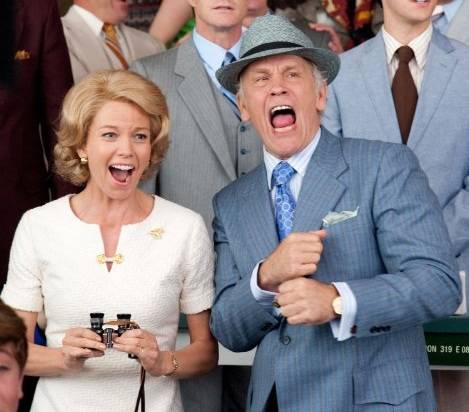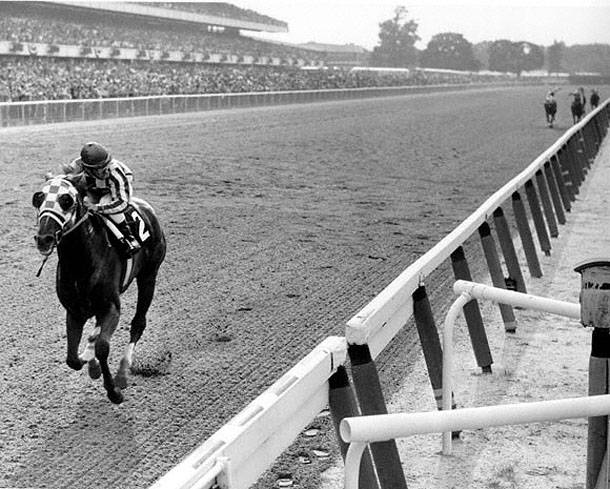I’ve been holding a grudge against Seabiscuit for several years. After all, he got a movie deal before the great Secretariat, and if any race horse deserved a movie made about him, it’s Secretariat. “Big Red” was the greatest race horse of all time; surely anybody with half a brain could see the potential in a great biopic, right? I should’ve been careful what I wished for. Now I’m holding a grudge against Seabiscuit because he got the better film treatment.
Being a person who lives and breathes both horse racing and movies, I went into this film with a unique perspective. Fully aware that Hollywood usually screws up a perfectly good story, I was willing to forgive a reasonable amount of factual errors or glossing-over of facts so long as they captured the magic of the true story. With Secretariat being my favorite race horse of all-time (and widely worshipped as a god by the general populous in the sport), I knew I would have to go into the film particularly restrained if I was going to hope to enjoy it.
 If you are unfamiliar with Secretariat, he was the big red race horse wearing white and blue silks that came onto the scene when America was broken from the Vietnam War and the beginnings of the Watergate scandal; it was this miracle horse, who became the first horse to win the Triple Crown after a 25-year drought, that brought the public together. The year was 1973 when Secretariat won the Kentucky Derby, Preakness, and Belmont, and his mark has been felt each time those races have been run since—no horse has surpassed his track record times in those three races, and no horse has ever displayed the versatility and sheer dominance of him in the history of the sport of kings.
If you are unfamiliar with Secretariat, he was the big red race horse wearing white and blue silks that came onto the scene when America was broken from the Vietnam War and the beginnings of the Watergate scandal; it was this miracle horse, who became the first horse to win the Triple Crown after a 25-year drought, that brought the public together. The year was 1973 when Secretariat won the Kentucky Derby, Preakness, and Belmont, and his mark has been felt each time those races have been run since—no horse has surpassed his track record times in those three races, and no horse has ever displayed the versatility and sheer dominance of him in the history of the sport of kings.
Directed by Randall Wallace, Disney’s Secretariat follows the story of his owner, Penny Tweedy, who broke the walls down in a man’s world and ended up saving the farm thanks to her steadfast belief in the superhorse. Diane Lane stars as Ms. Tweedy, and is only mildly convincing in this role as the strong woman who carried the burdens of her parents’ failing breeding farm. Lane plays the role with a breeziness, despite Tweedy’s hardships, but her strength is too Disney-fied to feel like this woman could put men in their places, as the real Penny did. Disney’s Secretariat feels more like a Lifetime made-for-TV movie than a feature film. Even the mighty John Malkovich, who portrays a flamboyant version of Secretariat’s trainer, Lucien Laurin, can’t mix things up enough for it to feel very exciting, and that’s saying a lot, given both the material they had to work with and the always-entertaining Malkovich. Otto Thorwarth plays Ron Turcotte, Secretariat’s jockey, but he doesn’t have enough lines or screen time for the audience to really get much out of his character, which is just as well, because the lines that come out of Diane Lane tend to border on plain cheesy. The best performance is delivered by Nelsan Ellis, who pulls off a quietly engaging performance as Red’s groom, Eddie Sweat, and actually has some chemistry with the horse actors.
The film is worth watching if you want an introduction to the sport of horse racing and the legendary Secretariat, but for those industry insiders and fans of Big Red, the movie fails miserably as a tribute to our greatest king. If you fall within the first bracket, and are curious about the real Secretariat after watching the movie, pick up Bill Nack’s book: Secretariat: The Making of a Champion. It’s telling that the film was supposed to be based on Nack’s book, but this acknowledgment was downgraded in the credits as merely “suggested by the story by Bill Nack;” the movie certainly feels like a major downgrade from the real thing. If you’re a fan of horse racing, watching Disney’s Secretariat is like hearing your favorite song through a monotone speaker; it sounds familiar, but all of the song’s power and punch have been reduced to a distant echo.
 There are moments that are just plain ridiculous. I tried very, very had to overlook some of the blatant atrocities, like filming the Belmont at quaint Keeneland Racecourse, a beautiful boutique racetrack that could fit inside the real Belmont’s massive infield. But I cannot forgive the laughable scene of Sweat, Tweedy, and friends dancing around Secretariat as they wash him at the farm to some gospel song on the radio while no one holds on to the horse’s lead shank. If you just syndicated a Thoroughbred race horse to stud for $6.08 million dollars, you would want to hold on to that horse with an iron grip. The film doesn’t even try to understand the racing industry or what it means for a 2-year-old to win Horse of the Year, or even accurately depict the aura surrounding the Kentucky Derby. You can’t tell me that they couldn’t have dubbed in three more layers of cheering fans to simulate the raucous, drunken festival that is the first Saturday in May? Clearly, the moviemakers must’ve scouted the tracks when there were about 5,000 people present, and not on a full-blown gambling-happy, drunken adrenaline rush that is the spirit of the most prestigious race in America. In comparison, the Kentucky Derby as depicted by Disney is a stroll along the promenade, full of appreciative fans golf-clapping the favorite in the post parade. And all of this came before I was truly disappointed in the film.
There are moments that are just plain ridiculous. I tried very, very had to overlook some of the blatant atrocities, like filming the Belmont at quaint Keeneland Racecourse, a beautiful boutique racetrack that could fit inside the real Belmont’s massive infield. But I cannot forgive the laughable scene of Sweat, Tweedy, and friends dancing around Secretariat as they wash him at the farm to some gospel song on the radio while no one holds on to the horse’s lead shank. If you just syndicated a Thoroughbred race horse to stud for $6.08 million dollars, you would want to hold on to that horse with an iron grip. The film doesn’t even try to understand the racing industry or what it means for a 2-year-old to win Horse of the Year, or even accurately depict the aura surrounding the Kentucky Derby. You can’t tell me that they couldn’t have dubbed in three more layers of cheering fans to simulate the raucous, drunken festival that is the first Saturday in May? Clearly, the moviemakers must’ve scouted the tracks when there were about 5,000 people present, and not on a full-blown gambling-happy, drunken adrenaline rush that is the spirit of the most prestigious race in America. In comparison, the Kentucky Derby as depicted by Disney is a stroll along the promenade, full of appreciative fans golf-clapping the favorite in the post parade. And all of this came before I was truly disappointed in the film.
 The one part of the movie I knew I could not forgive was if the filmmakers screwed up Secretariat’s Belmont Stakes victory, which is widely considered one of the all-time greatest performances in all of sports. Not just in horse racing. In all of sports. How is it possible to screw up one of the most impressive, exciting, and emotional events of all-time? Disney must teach a class on it, because they bombed this moment spectacularly. Not only do they butcher Chic Anderson’s famous race call, which, for some reason, remained in-tact for the less-memorable Derby and Preakness calls, they made the Belmont Stakes, the climax of the film, a cinematic train wreck. With choppy editing, shaky close-up camera shots, and a fake, un-inspired race call, Disney’s version of the Belmont is just another horse race at the movies. There is no emotion. There is no breath-taking scope. There is no drama. It all comes off false, and then the corny evangelical music comes in, and then the filmmakers succeed in making your jaw drop, because you can’t believe they just topped their own atrocity. It’s like if someone took the Mona Lisa and cut it to pieces and slapped it on the side of a bus so it would be easily accessible to everyone. They took something perfect, beautiful, and legendary, and not only ruined it, but defaced it.
The one part of the movie I knew I could not forgive was if the filmmakers screwed up Secretariat’s Belmont Stakes victory, which is widely considered one of the all-time greatest performances in all of sports. Not just in horse racing. In all of sports. How is it possible to screw up one of the most impressive, exciting, and emotional events of all-time? Disney must teach a class on it, because they bombed this moment spectacularly. Not only do they butcher Chic Anderson’s famous race call, which, for some reason, remained in-tact for the less-memorable Derby and Preakness calls, they made the Belmont Stakes, the climax of the film, a cinematic train wreck. With choppy editing, shaky close-up camera shots, and a fake, un-inspired race call, Disney’s version of the Belmont is just another horse race at the movies. There is no emotion. There is no breath-taking scope. There is no drama. It all comes off false, and then the corny evangelical music comes in, and then the filmmakers succeed in making your jaw drop, because you can’t believe they just topped their own atrocity. It’s like if someone took the Mona Lisa and cut it to pieces and slapped it on the side of a bus so it would be easily accessible to everyone. They took something perfect, beautiful, and legendary, and not only ruined it, but defaced it.
The best portrayal of the three big races in Disney’s Secretariat is the Preakness, the middle jewel of the Triple Crown. This is because they let you watch the actual, real-life 1973 Preakness footage originally broadcast on CBS without any horrible interjections. We are treated with seeing the real Big Red on the silver screen, and nothing is more precious than that. For anyone who knows horses, it also becomes quite clear that all the other horse actors they previously used to depict Secretariat in the film would’ve been Big Red’s waterboys in real life. You just can’t duplicate perfection, not even in the movies. He was that big, and that beautiful—something no Hollywood movie could ever replicate. I only wish it had been the Belmont footage, and not the Preakness, that had been used in the film, because then I may have walked away with some shred of joy after watching Disney’s adaptation of the “impossible true story.” Instead, I rushed home and pulled up the historic races on YouTube to exorcise the past two hours from my memory.
In other words, I’m ready for the remake.
For the love of God, click here to watch all of Secretariat’s actual races.








